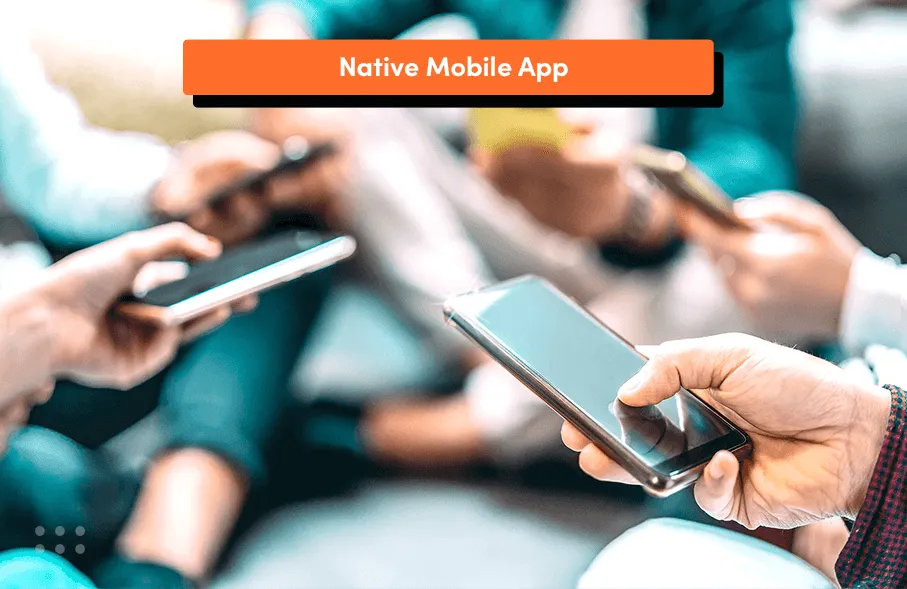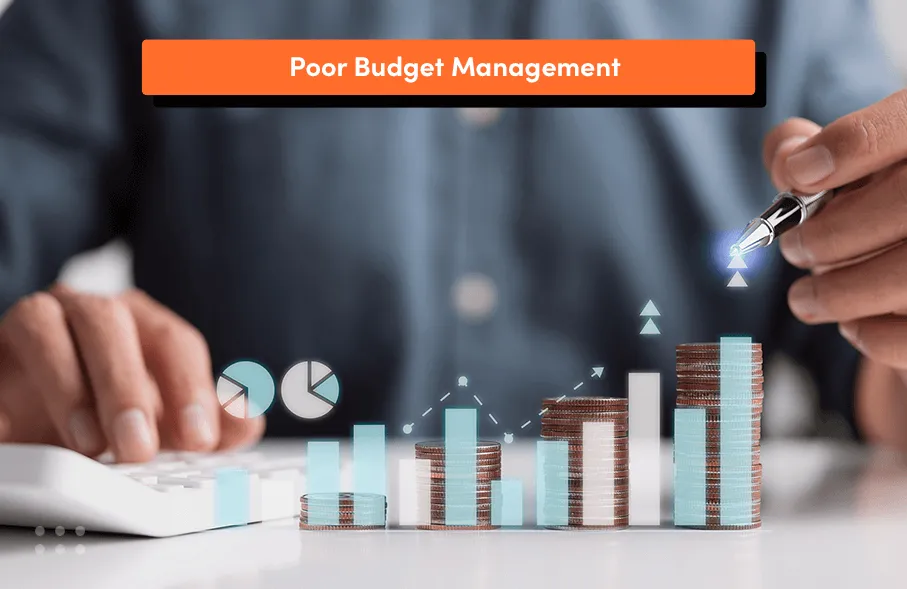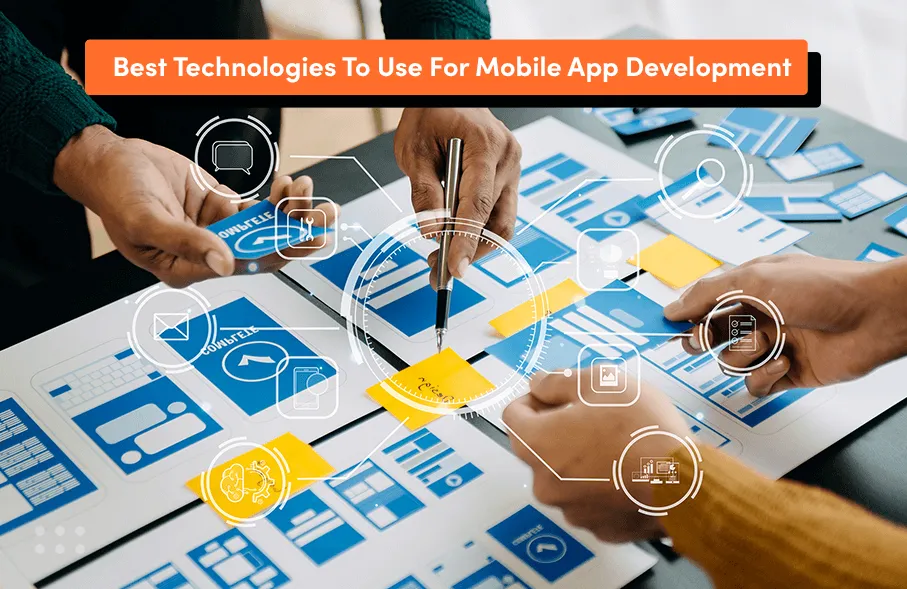Mobile applications have become a key tool for brands looking to strengthen their bond with customers and gain a competitive edge. However, the effectiveness of an application depends not only on the concept or functionality itself but also on a solid building process.
Did you know that mobile apps are expected to produce $188.9 billion in revenue by the end of this year via app stores and in-app ads? By 2031, the value of the business mobility market is expected to be $22.79 billion
So we will explore why it's worth paying attention to each stage of mobile app development and how proper management of this process can contribute to the success of a brand. From setting business goals, through user interface design, technology selection, risk management, to testing and iterative improvement - each step is crucial for the ultimate success of the application. Let's discover why the application building process is no less important than the mobile app idea itself.
What will you learn from this article:
- Best practices and common mistakes in app development for business.
- How to create a strategy and why it is important when building mobile applications?
- What are the costs of developing a mobile application in 2024?
- What can a company gain from a mobile application?
- Portfolio and examples of real mobile applications created for various companies.
9 Best Practices for Mobile Application Development
An effective mobile app development process consists of six key phases. Each phase is divided into sub-tasks. Regardless of the size and scope of your project, if you follow these best practices for design and development, your own app will be a great success.

Create A Strategy
The first step is deciding on a plan for turning your idea into an effective app. Since the goals of each app vary, there is also an app-specific effect on the mobile approach to consider throughout the development process. Each app is built with different development tools, and for separate mobile operating systems. It is very important to create a full-proof strategy.
In this phase, you will:
- Identify the target audience for the Android App or IOS App,
- Identify Competitors and research on them,
- Establish the app's goals and objectives,
- Select a mobile platform for your app,
Your approach aids in concentrating your vision on a single image of your app concept. With this in mind, you're ready to move on to develop an enterprise mobility strategy.
Read also: Mobile Software Development Trends To Know
5 Key Steps for Your Enterprise Mobility Strategy
Your digital transformation plan should include an enterprise mobility strategy. It can be challenging to come up with a plan for any organization. Your enterprise mobility plan, on the other hand, will scale business growth if done correctly.
#1. Define Your Business Needs - Enterprise mobile initiatives will help you solve problems in your marketing, reach new customers, and develop creative solutions to help you expand. Before you begin, you must first determine your company's requirements. Make an effort to comprehend the company's strategic objectives. To identify your business needs, use key performance indicators (KPIs), user feedback, and market trends.
#2. Perform Competitive Research -Now that you've determined your objectives, it's time to look at your rivals. Choose at least three rivals to study. Competitors should be chosen based on the company's goals and market trends. When identifying opponents, look for creative startups as well as top companies.
It is possible that none of your rivals has an app. That means you have a fantastic opportunity to be the industry leader!
#3. Set Strategic Goals and Objectives - The first two steps in our strategy guide will assist you in determining your requirements. Next, we'll set targets and priorities to help you arrange your needs.
Important questions to ask:
- Which apps will have the most impact on your business, employees, and users?
- Is your business ready to support this app?
- Is mobility the right channel to deliver the solutions your business needs?
Usefulness and scalability are two of the long-term implementation goals. You'll be collecting an unlimited amount of data on top of your regular usage.
Apple's iOS and Google's Android are the two most popular mobile platforms. These mobile platforms necessitate the use of their specific development environment when creating applications. The roles of a mobile app are tailored to each mobile device. This gives app users a personalized experience tailored to their mobile devices.
- Native Mobile Apps Native mobile applications are designed with iOS or Android in mind. They must be downloaded to a mobile phone or tablet from the Google Play Store or Apple App Store. Native smartphone applications have the most access to a device's firmware and hardware. This means native mobile applications will take advantage of all of the device's features. They are more expensive because they require separate development for iOS and Android. Some companies decide to create applications on both platforms.

- Mobile Web Apps - Websites that can be reached via a mobile browser are known as mobile web apps. Mobile web applications are sensitive and can mimic the look and feel of a native app. Both iOS and Android users will be able to use mobile web applications. This makes mobile web applications accessible in the same way as native apps are.
- Hybrid Apps / Cross-Platform Apps - There are two other methods for developing mobile apps. Third-party mobile frameworks such as Xamarin, Phonegap, and Appcelerator are used to create cross-platform mobile apps. These applications share a codebase and are compatible with all mobile platforms. They don't necessitate a lot of platform-specific code.
#4 Create a Plan for Continuous Delivery - The fight for market share between iOS and Android is fierce. Mobile technology is quickly evolving thanks to companies including Google, Samsung, and Apple. Every year, new mobile devices and platforms are released. Agility is essential for a successful mobility strategy because the landscape changes so rapidly. You'll need to think about short-term needs in addition to your long-term plan. In mobile app growth, you'll have to keep supporting your apps to fix bugs, add new features, and improve security flaws.
#5 Develop a Security Strategy - Last but not least, you must lay out your security plan and your internal governance policy.
Your governance policy should address:
- The development processes,
- Device provisioning,
- Data access and security,
- Interruption coverage / disaster recovery,
- Mobile application management,
- Ongoing infrastructure improvement needs.
Larger companies may need to form a governance team. Members of this team will serve each department that mobility solutions will impact.
Competitor Research
You will still find someone providing the same or similar services or products you plan to deliver, no matter how innovative your app design is. It is often preferable to observe what others are doing before making your own decisions.
For example, if you want to get into the food delivery market, look at what apps like Zomato and Swiggy are doing. Food delivery app production is a highly competitive industry, so if you want to participate, you must be prepared and keep an eye on what your competitors are doing. If you cannot do your research, you can have your mobile app development company do it for you.
Analysis and Planning
At this stage, your app idea begins to take shape and develop into a working project. Defining use cases and capturing detailed functional specifications are the first steps in the analysis and planning process.
Prepare a product roadmap after you've established the app's specifications. This involves prioritizing and separating mobile app specifications into delivery milestones. If you're short on time, resources, or capital, identify your minimum viable product (MVP) and prioritize it for the initial launch. If you want to know more about what does MVP stand for in business and why is it important in software projects? - Click on the link!
Identifying the skills required for your app development initiative is a part of the planning phase. The mobile platforms iOS and Android, for example, use separate development technology stacks. If you want to create a mobile app that works on iOS and Android, your mobile development team should include both iOS and Android developers.
Have you decided on a name for your app? Like domain names, mobile app names must be unique within each app store. Check each app store to make sure your app's name isn't already taken!
Choose the Platform
If you go the native path, you'll have to choose between developing for iOS or Android.
Return to the market research you did earlier on your target market. Find out what gadgets your potential customers are using. This will assist you in making your decision.

This is because Apple and Android users have different preferences. It's a big decision to figure out which platform your target audience uses the most. It's particularly crucial if you're only going to launch on one store at first.
If you want to create both native apps on your own, you will be taking on more than you can handle if you try to do so at the same time. You'll want your app to be available in both stores at some point. However, you might be forced to choose between the two at this time.
Keep Design the First Priority
Developers and designers are two very different types of people. Developers are known for being more technical, while designers are known for being more artistic. However, when it comes to app development, you can't keep your blinders on.
To code the app properly, you must first understand how the design components would function. Your whole team must be on the same page for designers and mobile app developers to collaborate effectively.
Make use of mood boards and other tools to help you coordinate your ideas and design features. This will simplify the creation process and reduce the likelihood of making several adjustments late in the game to satisfy the designers. You can also figure out the design elements in these early stages if you know how to develop and design.
Mockups & Prototypes
High-fidelity sketches, also known as mockups, are final renderings of the app's visual design. Your style guide is applied to the app wireframes to build mockups. Expect further changes to the app's information layout, workflow, and aesthetics as the design progresses. The most common tool for making high-fidelity mockups is Adobe Photoshop.
Prototypes are extremely useful for simulating the user interface and app workflows present in the final product. Although prototype creation can be time-consuming, it is well worth the effort because it allows you to test the design and functionality of your app at an early stage. Prototypes are often used to describe changes to the app's proposed features.
Choosing the Right Technology
As previously said, one of the most important factors in the performance of an app is the technology used. Every app is unique and each is designed to serve a specific function. As a result, it's critical to choose the right technology to meet your needs while still aligning with your business objectives. Furthermore, since each app development method follows a different process, it is critical to provide guidelines ahead of time to prevent any misunderstandings.
The app's intent determines the type of technology to use when creating an app. Depending on whether you want a native, hybrid, or cross-platform mobile app, you should look for the appropriate application. For native apps, you can use Java, Kotlin, or Objective-C, while for cross-platform apps, you can use either React Native app development or Flutter app development. You could also go for much lighter and faster apps and have a PWA built for your business.
Test Your App Many Times
Always monitor the output of your app before releasing it. Throughout the mobile development process, testing should be at the forefront of your mind. If you don't test the app regularly, finding and fixing bugs can be even more complex and complicated in the future. Standard checks can also assist you in lowering the overall costs.
Beta testers are a great way to get user feedback on your software. To find app testers, you can use online sites such as Beta Family. They'll provide input and even some suggestions for improving your app.
Deployment & Support
Users should be encouraged to provide feedback and suggestions for your app to your business. End-user support will be critical, as will regular software updates with new features. Unlike web applications, where patch releases are immediately accessible to app users, mobile app patches must go through the duplicate submission and approval process as the original submission. Furthermore, with native mobile applications, you must keep up with technological advances and upgrade your software regularly for new mobile devices and OS platforms.
11 Most Common Mistakes in App Development Process
App developers don’t like to make mistakes during development. But, sometimes, common mistakes are made unintentionally. If an app developer knows these common mistakes before starting the development process, a lot of time and money can be saved and chances of developing a successful app increase.

Let’s look at these common mistakes that every developer should avoid during the mobile app development process.
# 1: Focus only on Budget
Sometimes, companies focus mainly on budget and avoid all other aspects, which is one of the biggest mistakes leading to failure. If you hire a team with a lack of expertise just because they are within your budget, it will blow your mobile app development project. Similarly, if you spend more than the available budget, it can also be a total loss.
# 2: Not Listening to Users’ Feedback
Before choosing a freelancer or a development company, the best practice is to listen to what their previous and current clients are saying about them. Take their customers’ feedback and judge them based on those feedback before hiring them.
# 3: Lack of Research
You can’t decide to develop an app while sipping hot coffee at a coffee shop. It needs a lot of research. You need to research a lot of things such as:
- Company current standing,
- Purpose of building the app,
- Current market situation,
- Competitors,
- Pricing plans,
- Cost of developing the app,
- ROI on the app.
And the list goes on and on. Taking some time to research will save you months or even years of frustration down the road.
# 4: Poor Budget Management

Budget management is very crucial for successful app development. It is essential to have a rough idea of how much your app will cost from the beginning. The cost of each phase of development should be calculated before starting the process. Your budget should also allocate funds for unexpected expenses that could arise along the way. Always set realistic budget estimates from the beginning.
Read also: How To Build A Branding In Your Mobile App
# 5: Not Creating an MVP
Building a Minimum Viable Product (MVP) helps developers to test the app and evaluate performance. During the MVP stages of development, the app will only consist of essential features. Don’t consider an MVP as an experiment; that will be another mistake a developer shouldn’t make. It is a process of app development that helps to focus on the main component of the app.
# 6: Poor UI/UX Build
Never neglect the user interface of an app. A developer should have a clear idea of the app that will be used. The users usually uninstall apps with poor UI/UX in no time. People have certain expectations when they open an app. Follow the lead of the most successful and popular apps on the market today as an example.
# 7: Poor Communication during the Development Process
Most apps failed due to poor communication during the development process. The only way to avoid this mistake is by prioritizing communication from the beginning. Repeating your statement or instruction, again and again, is better than letting the developer assume from his/her mind. Depending on the scale of the app development project, teams can arrange bi-weekly or weekly meetings.
# 8: Overload the App with Functions & Features
No one likes the traffic jams. In the same way, an app with too many functions and features becomes hard to use for the customer. Just stick to the core features of what your app needs to function properly. Adding too many features creates problems for the app, such as slow response time and acquiring more space on the phone. Research shows that one in four people will delete an app for lack of phone storage.
# 9: Hiring a Wrong Development Team
Each app has different requirements, especially in terms of the experience and skills of a developer. A lot of great ideas just flopped because the wrong person was chosen to build the mobile app or comapny. Believe it or not, that can be the most expensive mistake you could ever make. Let's say you hire a freelancer to develop the app, and for some reason, the freelancer stops responding to your messages. You are unable to track him, and that causes delays in the delivery of your app. If you want to know how to choose a Mobile App Development Company. Click on the link!
If you want to become an app reseller, choosing the right development platform is the most important step in the process.
# 10: Improper Updates
The app development doesn’t stop when the app gets launched. It is an ongoing process as no app is perfect and needs constant improvements. About 30% of apps are updated at least once a month. More than 80% of apps are updated every six months.
Choose an app builder that provides full-service and maintenance even after you finish app building software.
# 11: Don’t make Mobile App a Clone of your Website
Mobile apps perform better than mobile websites. The reason for the better performance of apps on mobile is their functionality and features that a mobile website cannot offer. Therefore cloning your mobile website as your mobile app is a total waste of time and money.
If the app isn’t different from the mobile site, why should your customer bother downloading the app?
You can use the same theme, color, fonts, and branding image on your app, but it should be different in features and functions.
Try our developers.
Free for 2 weeks.
No risk. Just results. Get a feel for our process, speed, and quality — work with our developers for a trial sprint and see why global companies choose Selleo.
Best technologies for mobile app development

Building a mobile application is now a need of every business. It is observed that businesses with mobile applications can generate more revenue than traditional ones. But building an application requires finding the right choice of technologies as per the requirements. Here are some of the most famous technologies/frameworks being used for developing mobile applications.
React Native - It is the most famous open-source framework introduced by Facebook. This dynamic framework allows us to build cross-platform mobile applications for both Android and IOS. The apps built on React Native offer services that can be supported on multiple platforms. Moreover, if we integrate Javascript with React Native then it enables us to build applications with seamless user experience on multiple platforms.
Here you can check out our portfolio of applications that we have created in React for businesses:
- Defined Careers - application for e-learning,
- Velory - eCommerce B2B platform that integrates an asset management system with a store,
- Qstream - application microlearning SaaS-based tool,
- Catalyst - A HIPAA-compliant video conferencing platform.
Flutter - Flutter is another open-source framework for creating cross-platform applications. It was introduced by Google back in 2017. This dynamic app development SDK for mobile apps can create apps for both Android and IOS devices.
Flutter uses Dart programming language that allows the developers to create native interfaces that can be supported on IOS and Android. Platforms like flutter save potential time and effort for the developers while creating a single application for multiple platforms.
Swift - Swift is known as a general-purpose language introduced by Apple Inc. Swift allows us to work on Cocoa Touch and Cocoa frameworks. Swift can be used on macOS. IOS, Linux, tvOS and so on. Swift is frequently used for building applications ranging from startups to large enterprises.
It also provides a cross-platform facility. It offers an effective code-writing style along with a playground mode that allows the developers to explore and make creative designs. This language is also being used for creating modern-day service applications. The only limitation of this language is that it doesn’t support creating apps for Android.
Python - Today Python is known as one of the most used languages for developing mobile applications worldwide. Due to its dynamic nature, it is famous among developers and also in companies. Even complex tasks can be done in python with ease.
Python is an open-source programming language that supports high-level OOP (Object Oriented Programming). This dynamic language can be utilized for creating and debugging applications. Python is the choice for building scalable mobile apps that are enriched with useful features in a short time.
Java - It is perhaps the oldest of all the technologies listed here that supports object-oriented programming. It is known as a highly secure programming language that is easy to use. Because it is the oldest language that’s why we have huge community support along with comprehensively detailed documentation and it also offers many open-source libraries.
Kotlin - Kotlin is the choice if you want to develop a complex application for your business idea. It offers a cross-platform programming language and is also known as the latest version of Java. Kotlin is used to develop Android applications efficiently as it is safe, clear and provides a large number of tools.
Iconic - Iconic is another open-source framework for developing applications. This framework is HTML based so it mainly focuses on the UI and looks of the app. This framework is the best choice when you need to meet tight deadlines and manage development on a limited budget.
Xamarin - Xamarin was developed by Microsoft originally for .Net developers to make modern-day apps for both Android and IOS. It is also an open-source framework that is also multi-platform supported and uses C++ programming language to build apps.
Benefits of developing a mobile app

Let's look at some advantages of developing your own mobile app or a mobile version of your existing product.
Provide sufficient value to Potential customer
In recent years the trends of business growth have changed drastically. Companies and businesses now depend on technologies and try to invent new features for the ease of their Potential customer Mobile applications are considered modern-day technologies being used in business and it has changed the trends of shopping while fulfilling all the customer’s needs. These apps are giving ease to the customers by providing everything in one place.
Stronger Bond with Customers
It is observed that if you give your customers all they want then they can trust your brand more and value your products. Every brand requires deliberate efforts to become its customer’s favorite and achieve its goals.
Fast and Easy source to connect with Customers
In the modern era customers mainly focus on how quickly and easily they can get their desired information about any company. Customer support is one of the main hubs from where the business grows. If you want to deliver speedy customer support then a mobile app is the best option for it. It is a reliable, personal and convenient source for providing the best experience. Meanwhile, it is beneficial for the employees as well to get their desired information and also to get feedback from your potential customers.
Enhance Customer Loyalty
Every successful business always has a high rate of retention for its customers. It is obvious when you provide high-level services to your potential customers then they rely on your brand/products and also recommend them to others.
Introducing loyalty programs is one of the best ways to gain your customer’s attention. Mobile apps can be extremely beneficial to implement those loyalty programs. You can offer instant rewards to your customers, Provide them with product recommendations as per their desire. Add social media share buttons to encourage your potential customers to share your products with their friends and family.
Competitive Edge in your niche
Gaining a competitive edge against your potential competitors is itself a huge task. Mobile apps can change giving you a good edge to gain a competitive edge in your niche. When your potential customers will be able to get their desired things with the ease of their smartphone then they will surely come again.
Higher Customer Engagement
To improve your brand devotion and revenue you should focus more on your customer engagement level. If you’re able to boost your customer engagement level then there are high chances of getting more customers and returning customers. To gain a certain level of engagement you need to add more user-friendly features to your app. One of the main features is to add segmented targeting where you add multiple categories and control the content type for your potential customers.
Introduce your Marketing Source
The marketing department plays the role of bridge between the customer and the brand. When the brand is accessible to the end user from their smartphone then digital marketers can be super helpful to increase customer involvement. Data collected from your visiting user sessions can benefit in developing marketing campaigns. There are many marketing ways to attract your potential customers but some of the important ones are Push Notifications, Clickthrough rate inside apps, and Keeping an eye on the response time of your app.
Integrate Social Media channels
Driving engagement of your customers can be easily achieved using social media platforms. Integrating social media platforms with your app and promoting your brand on social media can drive more engagement of users. You can get downloads, encourage your potential customers to sign up from their social media accounts and get exciting deals. It will also increase social media sharing of your brand products and can engage more new customers.
Provide Unique and attractive features and services
To compete with your potential competitors and gain more customer interest then you need to provide unique services and features. Adding more features can boost your customer interest and help your brand in achieving good scores. Brand marketing is a challenging task considering the technological evolution. However, a brand app that is packed with good unique features may help you get your desired results.
What does app development cost in 2024?
The cost of app development in 2024 can vary widely depending on a multitude of factors such as:
- App features and their complexity,
- user engagement features you want to include,
- platform(s) you're targeting (iOS, Android, or both),
- In-app purchases,
- Location-based services or geographical location of your development team (cost of app development by region),
- Device features.
However, I'll break it down in a general sense:
Basic Estimates
- Simple Apps: A basic app with a handful of features might range from $30,000 to $50,000.
- Moderate Complexity Apps: These are apps with more features, like in-app purchasing, a backend server, or third-party integrations. Prices could range from $50,000 to $100,000.
- Complex Apps Think of enterprise-level apps with advanced features like real-time updates, heavy user interaction, custom animations, etc. These can easily cost upwards of $100,000 to $500,000 or more.
Cost Breakdown by Development Phase
- Discovery & Planning: $5,000-$10,000,
- UI/UX Design: $10,000-$25,000,
- Development: $50,000-$400,000 depending on complexity,
- Testing: $10,000-$20,000,
- Deployment & Launch: $5,000-$10,000,
- Maintenance: Approximately 20% of the development cost annually.
These figures are ballpark estimates, and actual costs can vary widely based on the specific needs and circumstances of each app development project.
Additional Costs
- Backend Development: If your app requires a backend, this could add a substantial amount to the overall cost.
- Third-Party Integrations: APIs, SDKs, and other third-party services can also add to the cost.
- Location of Development Team: U.S.-based developers typically charge from $100 to $250 per hour, whereas Eastern European or Asian teams might charge between $30 and $100.
In summary, the cost of app app-making process in 2024 can be quite variable, and it ultimately depends on what you need the app to do, how you're building it, and who's building it for you. Budgeting accurately will require a detailed scope of work and often some initial discovery phases to get a more precise estimate.
Conclusion
Having a mobile app has become essential for all kinds of businesses. The mobile app development process is never-ending. You need to make adjustments and changes based on users’ feedback. Adding new features is another important aspect. So, if you are looking for a mobile app development company, search for one that can provide you with a complete range of services even after the development process is completed.





